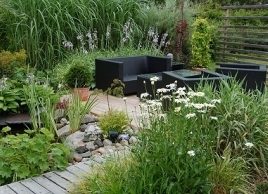Creating a low-allergen garden
Our homes and garden are our last refuge from the stresses of the world, but they are not always safe havens from allergies. Both indoor and outdoor air can be polluted and may have a serious effect on your nose and throat

Source: Adapted from Your Body Your Health: The Ears, Nose & Throat, Reader’s Digest
Although you can’t eliminate all the airborne pollutants from the outdoor environment, you can significantly reduce their concentration in your own garden.
Garden irritants
Two of the biggest garden allergy irritants are pollen from trees, flowers, grass and weeds, and spores from molds and fungi growing in rotting vegetation.
Mold spores are the reproductive particles of mold. Each spore can give rise to a new mold that can produce millions more spores. Both the spores and the tiny fragments of mold can cause allergic rhinitis (hay fever) if they are inhaled.
People who suffer from hay fever are sensitive to pollen and molds and can have acute symptoms including a runny or stuffy nose, inflammation of the nose and throat, irritation of the eyes and inflammation of the sinuses.
Creating your low-allergen garden
- Hedges can give rise to mold and spores. Replace them with fences or brick walls.
- Don’t plant vines too close to the house where their scent can drift through open windows.
- Select insect-pollinated rather than wind-pollinated species.
- Make the most of moisture-loving pool and marginal plants, which do not usually cause allergies.
- Dampen the air by adding a water feature to your garden, but avoid fountains that make pollen and spores airborn.
- Use low-allergen ground cover plants such as periwinkle and hosta to suppress weeds.
A few last-minute tips
- Avoid compost heaps and piles of logs, which can harbour mold spores.
- Try not to use heavily scented plants.
- Mulch with gravel or pebbles; hay, straw and bark chips may harbour allergy-causing molds and spores.
- Create a paved area close to the house and minimize the size of your lawn.
Found this article informative? Subscribe to our magazine today and receive more Best Health exclusives delivered to your door!




